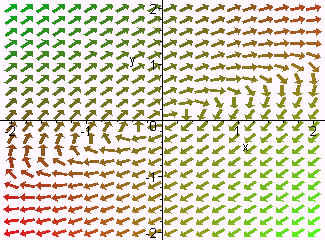Systems with Complex Eigenvalues
In the last section, we found that if
x' = Ax
is a homogeneous linear system of differential equations, and r is an eigenvalue with eigenvector z, then
x = zert
is a solution. (Note that x and z are vectors.) In this discussion we will consider the case where r is a complex number
r = l + mi
First we know that if r = l + mi is a complex eigenvalue with eigenvector z, then
r = l - mi
the complex conjugate of r is also an eigenvalue with eigenvector z. We can write the solution as
x = k1ze(l + mi)t + k2ze(l - mi)t
We can use Euler's formula to get
x = k1zelt(cos(mt) + i sin(mt)) + k2zelt(cos(mt) - i sin(mt))
Writing
z = a + bi and z = a - bi
We get
x = k1(a + bi)elt(cos(mt) + i sin(mt)) + k2(a - bi)elt(cos(mt) - i sin(mt))
Now multiplying and separating into real and imaginary parts, we get
x = elt[k1(a cos(mt) - b sin(mt) + i(a sin(mt) + bcos(mt)))
+ k2(a cos(mt) - b sin(mt) - i(a sin(mt) + bcos(mt)))]
Now let
k1 + k2 = 2c1 and (k1 - k2)i = 2c2
Then we get
x = elt[c1(a cos(mt) - b sin(mt)) + c2(a sin(mt) + bcos(mt))]
Example
Solve the system of differential equationsx' = -2x + 6y
y' = -3x + 4y
Solution
We have
![]()
To find the eigenvalues, we find the determinant of
![]()
We get
(-2 - r)(4 - r) + 18 = r2 - 2r + 10 = 0
The quadratic formula gives the roots
r = 1 + 3i and r = 1 - 3i
Now we find and eigenvector corresponding to the eigenvalue 1 + 3i. Plugging into A - rI, we get
![]()
The top row gives
(-3 - 3i)x + 6y = 0
or
(1 + i)x - 2y = 0
An eigenvector is
![]()
Hence the general solution is

This can be written as
x = et[2c1cos(3t) + 2c2sin(3t)]
y = et[c1(cos(3t) + sin(3t)) + c2(sin(3t) + cos(3t))]
Below is the phase portrait

We can see that the solutions spiral out from the origin. This situation is called a spiral node. The spiral occurs because of the complex eigenvalues and it goes outward because the real part of the eigenvalue is positive. If the real part of the eigenvalue had been negative, then the spiral would have been inward.
Back to the Power Series Methods and Laplace Transforms Home Page
Back to the Differential Equations Home Page
Back to the Math Department Home Page
e-mail Questions and Suggestions